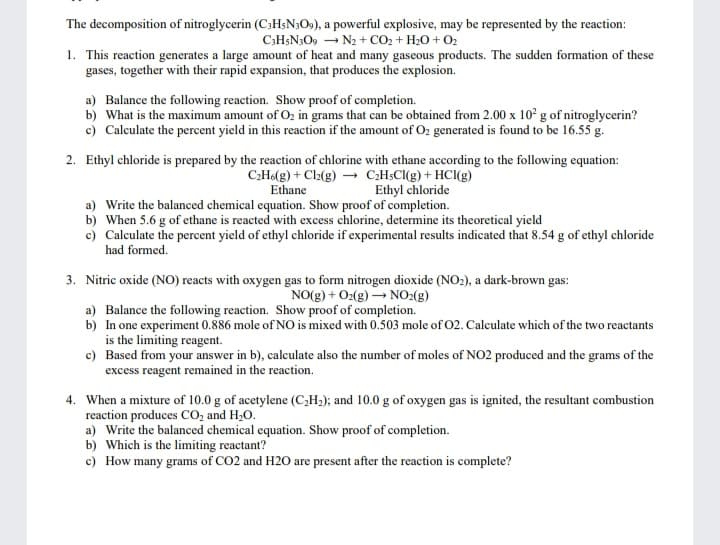The decomposition of nitroglycerin (C3HSN;O»), a powerful explosive, may be represented by the reaction: C:HsN;O, - N2 + CO2 + H20 + O2 1. This reaction generates a large amount of heat and many gascous products. The sudden formation of these gases, together with their rapid expansion, that produces the explosion. a) Balance the following reaction. Show proof of completion. b) What is the maximum amount of Oz in grams that can be obtained from 2.00 x 10° g of nitroglycerin? c) Calculate the percent yield in this reaction if the amount of O: generated is found to be 16.55 g.
The decomposition of nitroglycerin (C3HSN;O»), a powerful explosive, may be represented by the reaction: C:HsN;O, - N2 + CO2 + H20 + O2 1. This reaction generates a large amount of heat and many gascous products. The sudden formation of these gases, together with their rapid expansion, that produces the explosion. a) Balance the following reaction. Show proof of completion. b) What is the maximum amount of Oz in grams that can be obtained from 2.00 x 10° g of nitroglycerin? c) Calculate the percent yield in this reaction if the amount of O: generated is found to be 16.55 g.
Chemistry: Matter and Change
1st Edition
ISBN:9780078746376
Author:Dinah Zike, Laurel Dingrando, Nicholas Hainen, Cheryl Wistrom
Publisher:Dinah Zike, Laurel Dingrando, Nicholas Hainen, Cheryl Wistrom
Chapter11: Stoichiometry
Section: Chapter Questions
Problem 59A
Related questions
Question
100%

Transcribed Image Text:The decomposition of nitroglycerin (C3H3N;O,), a powerful explosive, may be represented by the reaction:
C;HŞN3O9 – N2 + CO2 + H20 + O2
1. This reaction generates a large amount of heat and many gaseous products. The sudden formation of these
gases, together with their rapid expansion, that produces the explosion.
a) Balance the following reaction. Show proof of completion.
b) What is the maximum amount of Oz in grams that can be obtained from 2.00 x 10° g of nitroglycerin?
c) Calculate the percent yield in this reaction if the amount of O2 generated is found to be 16.55 g.
2. Ethyl chloride is prepared by the reaction of chlorine with ethane according to the following equation:
C:Ho(g) + Cl2(g) → C:H$CI(g) + HC(g)
Ethane
Ethyl chloride
a) Write the balanced chemical equation. Show proof of completion.
b) When 5.6 g of ethane is reacted with excess chlorine, determine its theoretical yield
c) Calculate the percent yield of ethyl chloride if experimental results indicated that 8.54 g of ethyl chloride
had formed.
3. Nitric oxide (NO) reacts with oxygen gas to form nitrogen dioxide (NO:), a dark-brown gas:
NO(g) + O:(g) NO2(g)
a) Balance the following reaction. Show proof of completion.
b) In one experiment 0.886 mole of NO is mixed with 0.503 mole of 02. Calculate which of the two reactants
is the limiting reagent.
c) Based from your answer in b), calculate also the number of moles of NO2 produced and the grams of the
excess reagent remained in the reaction.
4. When a mixture of 10.0 g of acetylene (C,H;); and 10.0 g of oxygen gas is ignited, the resultant combustion
reaction produces CO, and H,O.
a) Write the balanced chemical equation. Show proof of completion.
b) Which is the limiting reactant?
c) How many grams of CO2 and H20 are present after the reaction is complete?
Expert Solution
This question has been solved!
Explore an expertly crafted, step-by-step solution for a thorough understanding of key concepts.
This is a popular solution!
Trending now
This is a popular solution!
Step by step
Solved in 5 steps with 7 images

Knowledge Booster
Learn more about
Need a deep-dive on the concept behind this application? Look no further. Learn more about this topic, chemistry and related others by exploring similar questions and additional content below.Recommended textbooks for you

Chemistry: Matter and Change
Chemistry
ISBN:
9780078746376
Author:
Dinah Zike, Laurel Dingrando, Nicholas Hainen, Cheryl Wistrom
Publisher:
Glencoe/McGraw-Hill School Pub Co

Chemistry: The Molecular Science
Chemistry
ISBN:
9781285199047
Author:
John W. Moore, Conrad L. Stanitski
Publisher:
Cengage Learning

Introductory Chemistry: A Foundation
Chemistry
ISBN:
9781337399425
Author:
Steven S. Zumdahl, Donald J. DeCoste
Publisher:
Cengage Learning

Chemistry: Matter and Change
Chemistry
ISBN:
9780078746376
Author:
Dinah Zike, Laurel Dingrando, Nicholas Hainen, Cheryl Wistrom
Publisher:
Glencoe/McGraw-Hill School Pub Co

Chemistry: The Molecular Science
Chemistry
ISBN:
9781285199047
Author:
John W. Moore, Conrad L. Stanitski
Publisher:
Cengage Learning

Introductory Chemistry: A Foundation
Chemistry
ISBN:
9781337399425
Author:
Steven S. Zumdahl, Donald J. DeCoste
Publisher:
Cengage Learning

Chemistry & Chemical Reactivity
Chemistry
ISBN:
9781133949640
Author:
John C. Kotz, Paul M. Treichel, John Townsend, David Treichel
Publisher:
Cengage Learning

Chemistry & Chemical Reactivity
Chemistry
ISBN:
9781337399074
Author:
John C. Kotz, Paul M. Treichel, John Townsend, David Treichel
Publisher:
Cengage Learning

General Chemistry - Standalone book (MindTap Cour…
Chemistry
ISBN:
9781305580343
Author:
Steven D. Gammon, Ebbing, Darrell Ebbing, Steven D., Darrell; Gammon, Darrell Ebbing; Steven D. Gammon, Darrell D.; Gammon, Ebbing; Steven D. Gammon; Darrell
Publisher:
Cengage Learning